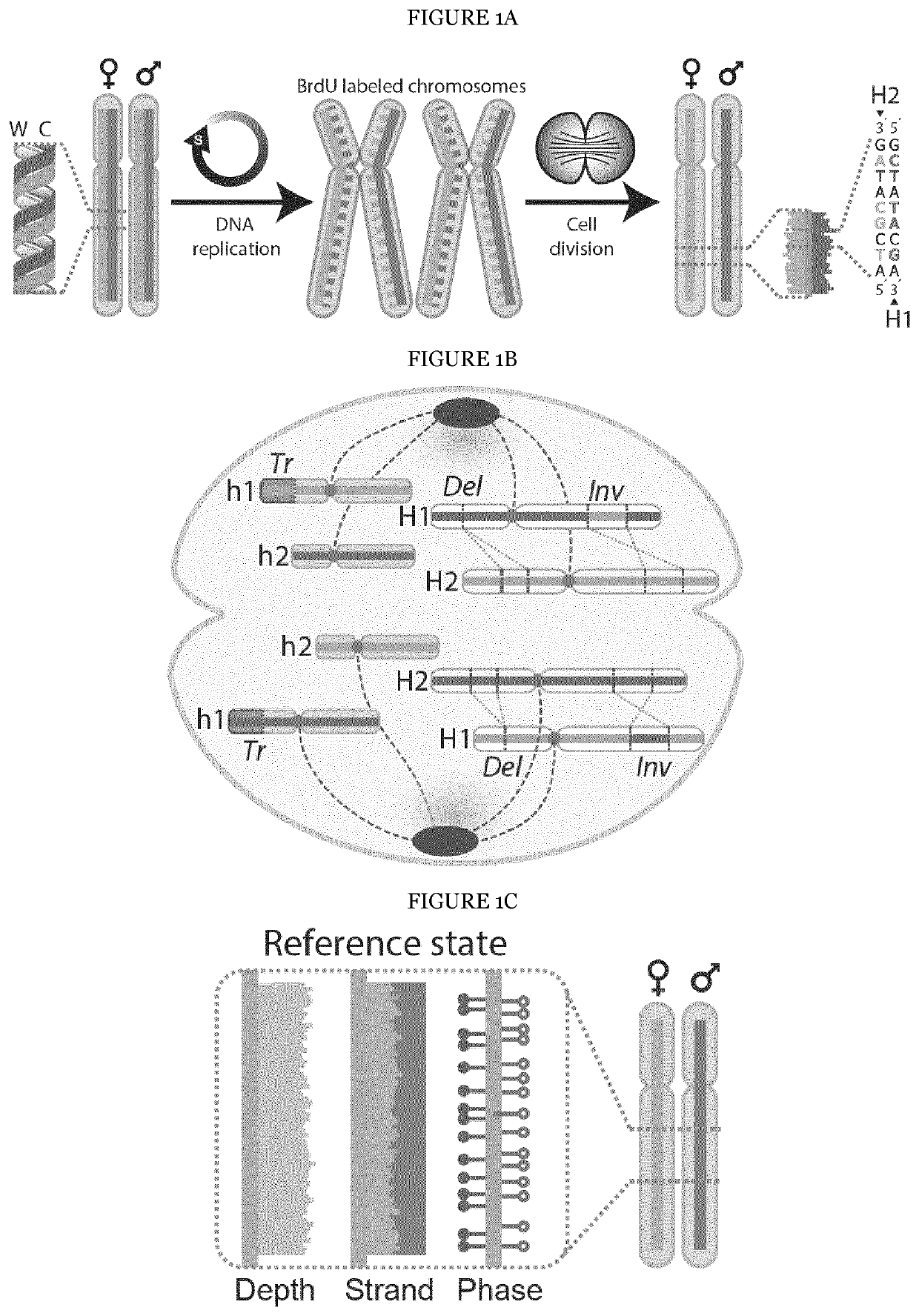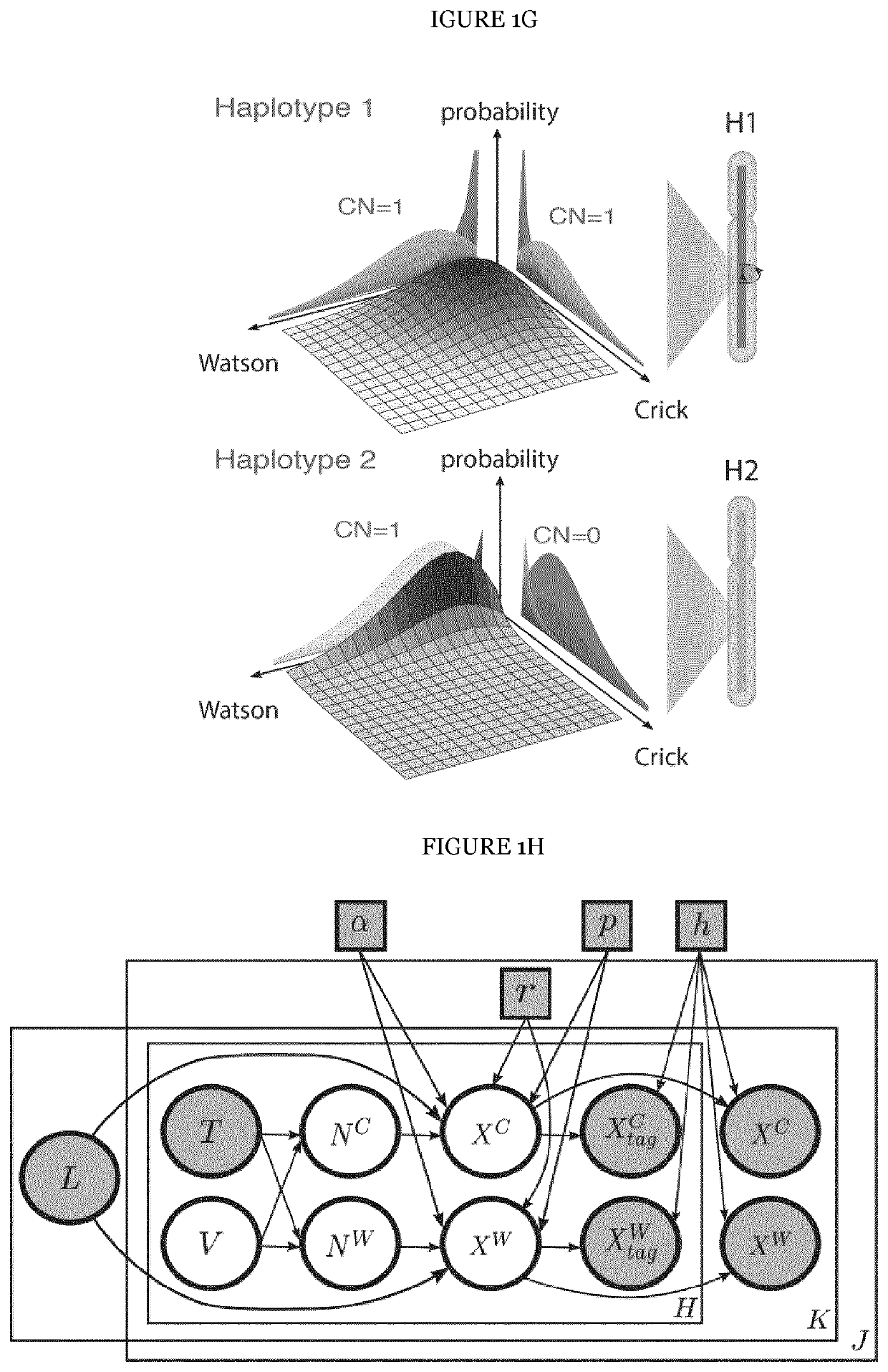Comprehensive detection of single cell genetic structural variations
a single cell, genetic structural technology, applied in the field of comprehensive detection of single cell genetic structural variations, can solve the problems of limiting the utility of sv detection in heterogeneous contexts, sv discovery remains challenging, and svs represent a particularly difficult-to-identify class of variation, so as to achieve a different diagnostic footprint
- Summary
- Abstract
- Description
- Claims
- Application Information
AI Technical Summary
Benefits of technology
Problems solved by technology
Method used
Image
Examples
example 1
ables Systematic Discovery of a Wide Variety of SV Classes in Single Cells
[0202]The underlying rationale of scTRIP is that each class of SV can be identified via a specific ‘diagnostic footprint’. These diagnostic footprints capture the co-segregation patterns of rearranged DNA segments made visible by sequencing single strands of each chromosome in a cell, as follows: During S-phase, the DNA double strand unwinds, and the two resulting single strands (Watson [‘W’] and Crick [‘C’]) act as templates for DNA replication. In Strand-seq, newly replicated strands incorporate Bromodeoxyuridine (BrdU)21, which acts as a traceable label for these non-template strands (see FIG. 1A depicting the Strand-seq protocol)24. During mitosis, each of the two daughter cells receive one copy of each chromosomal homolog through independent and random chromatid segregation21. The labeled nascent strand is then removed, and the segregation pattern of each chromosomal segment is analyzed following strand-s...
example 2
apes of RPE Cells Uncovered by scTRIP
[0232]To investigate single cell SV landscapes using scTRIP the inventors next generated strand-specific DNA sequencing libraries from telomerase-immortalized retinal pigment epithelial (RPE) cells. hTERT RPE cells (RPE-1) are commonly used to study patterns of genomic instability20,27-29, and additionally C7 RPE cells were used, which show anchorage-independent growth used as an indicator for cellular transformation30. Both RPE-1 and C7 cells originate from the same anonymous female donor. The inventors sequenced 80 and 154 single cells for RPE-1 and C7, respectively, to a median depth of 387,000 mapped non-duplicate fragments (Methods). This amounts to only 0.01× genomic coverage per cell.
[0233]The inventors first searched for Dels, Dups, Invs and InvDups. Following read normalization, 54 SVs in RPE-1 were identified, and 53 in C7 cells. 22 SVs were present only in RPE-1, and 21 were present only in C7, and thus likely correspond to sample-spec...
example 3
g Complex Cancer-Related Translocations in Single Cells
[0234]To assess the ability of scTRIP to detect a wider diversity of SV classes, the inventors subjected RPE-1 cells to the CAST protocol28: the inventors silenced the mitotic spindle machinery to construct an anchorage-independent line (BM510) likely to exhibit genome instability. The inventors sequenced 145 single BM510 cells detecting overall 67 SVs when searching for Dels, Dups, Invs and InvDups events. Additionally, several DNA segments did not segregate with the respective chromosomes they originated from, indicating inter-chromosomal SV formation (FIG. 3A). The inventors performed translocation detection with scTRIP searching for diagnostic co-segregation footprints (FIG. 3B), and identified four translocations in BM510 (FIG. 3B,C). The inventors additionally subjected RPE-1 and C7 to translocation detection, identifying one translocation each (FIG. 3D).
[0235]One translocation was shared between RPE-1 and BM510 and involv...
PUM
 Login to View More
Login to View More Abstract
Description
Claims
Application Information
 Login to View More
Login to View More - R&D
- Intellectual Property
- Life Sciences
- Materials
- Tech Scout
- Unparalleled Data Quality
- Higher Quality Content
- 60% Fewer Hallucinations
Browse by: Latest US Patents, China's latest patents, Technical Efficacy Thesaurus, Application Domain, Technology Topic, Popular Technical Reports.
© 2025 PatSnap. All rights reserved.Legal|Privacy policy|Modern Slavery Act Transparency Statement|Sitemap|About US| Contact US: help@patsnap.com



